An above-ground pool is like a frozen pizza: functional, but no one’s bragging about it. That was true. Until stock tank pools showed up.
Once a humble piece of farm equipment, the stock tank has become an unlikely summer hero. Galvanized steel. Round. Affordable. Surprisingly chic. It’s basically the Birkenstock of backyard upgrades: a little rustic, weirdly fashionable, and built to last.
And people are loving it. Google searches for “stock tank pool” have surged in the last two years, and there’s a reason DIYers, designers, and families are all on board. It’s the rare project that checks all the boxes: quick to install, easy to maintain, and extremely Instagrammable.
But this isn’t just about looks. If you’re working with a tight budget, limited space, or big renovation fatigue, a stock tank pool offers a refreshing, low-commitment way to reclaim your outdoor space. Cool down, chill out, and actually enjoy your backyard without taking out a loan or applying for permits.
This guide will walk you through the good, the bad, and the oddly satisfying process of turning a livestock water tub into your new favorite retreat. Let’s build something cold, circular, and excellent.
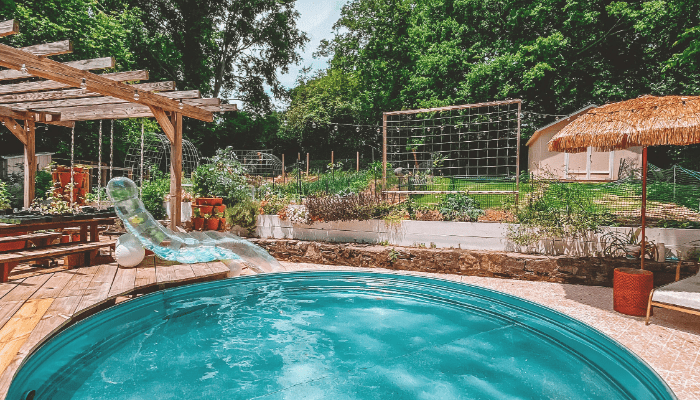
Key Takeaways
- Stock tank pools are repurposed galvanized or poly livestock tanks (6-10 ft diameter) turned into stylish, compact pools.
- Popular for being affordable, quick to set up, low-maintenance, and perfect for small backyards or patios.
- DIY builds are cheaper and customizable, while ready-made options offer polished finishes and built-in pumps.
- Basic setup needs: level base, plumbing/pump, chlorine treatment, and regular skimming/cleaning.
- Cost: DIY from ~€500-€1,000 and prebuilt setups can run from €2,000-€5,000+.
- Design upgrades include decks, paint, shade sails, and surrounding landscaping for a polished look.
Disclaimer: All images are from external sources and we do not claim copyright on any of the pictures.
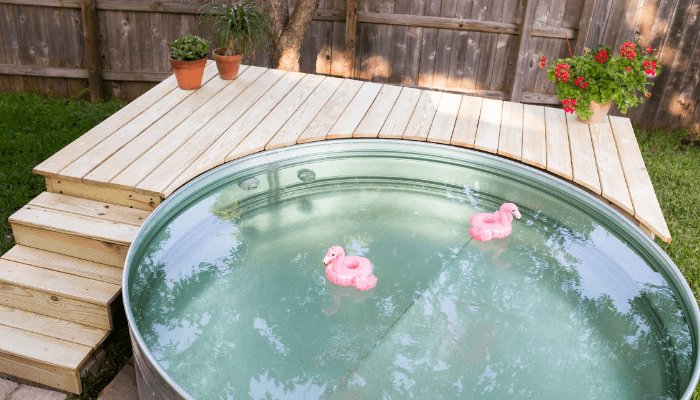
What Is a Stock Tank Pool?
First, it held water for cows. Now, it holds cold drinks and people trying to escape the heat.
A stock tank pool is exactly what it sounds like: a galvanized or poly tank (originally used for livestock) repurposed into a stylish, compact swimming pool. Sizes usually range from 6 to 10 feet in diameter and hold anywhere from 300 to 800 gallons of water.
The appeal? It’s part affordability, part charm, and a whole lot of “wow, that actually works.” What used to be tucked behind barns is now front and center in design blogs and backyards across the country. Stock tank pools are easy to install, surprisingly durable, and far more photogenic than their above-ground cousins.
Whether you call it a cowboy pool, a garden plunge tub, or a DIY miracle, the concept is the same: keep it simple, keep it cool.
Why Stock Tank Pools Are So Popular
Because let’s be honest: traditional pools are great, but they cost as much as a small car and take months to install. Inflatable pools? Fun for three days. Then they deflate, get patchy, or turn into mosquito farms.
Stock tank pools hit the sweet spot. They’re low-cost, fast to set up, and instantly boost the vibe of any outdoor space. Perfect for small yards, patios, or urban gardens.
They’re also refreshingly low-maintenance. With the right setup, they stay clean, cool, and algae-free with minimal effort. And they look good while doing it. Think galvanized steel, black matte paint, smooth wooden decks, string lights, and a cold drink within reach.
It’s part practical, part aesthetic, and part middle finger to overpriced renovations.
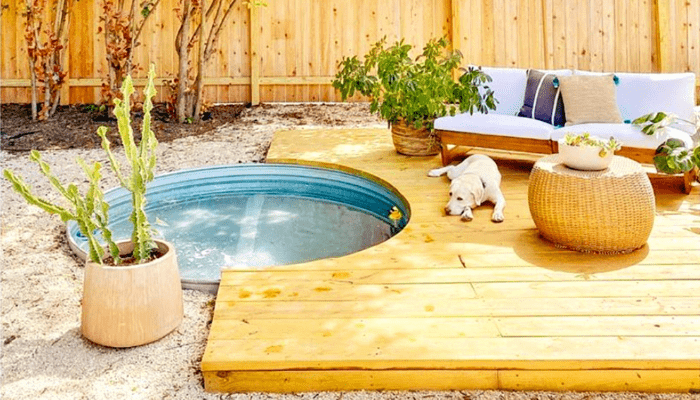
DIY vs. Ready-Made: What You Need to Know
Let’s get something out of the way: yes, you can do this yourself. And yes, it’s actually kind of fun.
DIY Stock Tank Pool Pros:
- Lower cost
- Customizable look and layout
- Sense of pride when you sit in water you personally plumbed
DIY Cons:
- You’ll be learning on the fly
- Requires tools, patience, and possibly a YouTube spiral
- If you mess up the plumbing, your yard turns into a marsh
You’ll need:
- Stock tank (galvanized or poly)
- Submersible pump or external filter system
- Sealant (for any drilled areas)
- Floating chlorine dispenser
- Optional: paint, decking, umbrella, ladder
Ready-Made or Custom Options:
- More expensive, but you’re paying for polish
- Comes pre-sealed and often includes pump/filter
- Brands like Cowboy Pools, Gypsy Pools, and Tankkd offer some very cool setups
So, DIY if you like getting your hands dirty. Buy pre-built if you just want to get wet by Saturday.
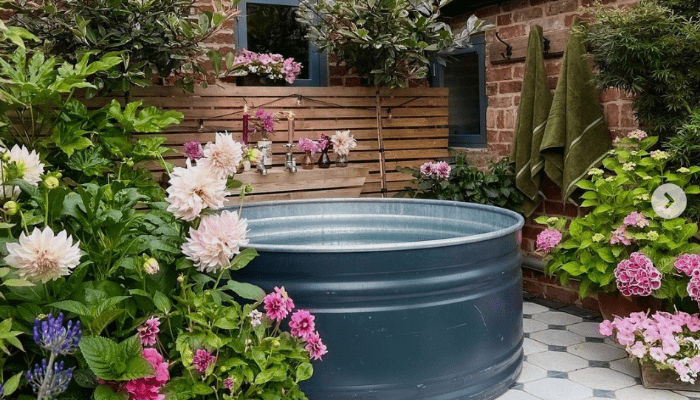
How to Set Up a Stock Tank Pool (Step-by-Step)
Step 1: Pick the Right Size
- A 6-foot tank is perfect for two people.
- A 10-foot version can fit the whole friend group (or a very spoiled golden retriever).
Step 2: Prep the Ground
- Clear and level the area
- Use crushed granite, sand, or pour a concrete pad
Step 3: Add Plumbing
- Drill holes for intake/outflow if adding a pump
- Seal connections tight with silicone or FlexSeal
Step 4: Fill It Up
- Use a garden hose. It’ll take an hour or two. Time to cue up a playlist.
Step 5: Maintain It
- Drop in a chlorine puck
- Skim leaves every few days
- Clean once a month
Optional: Pimp Your Pool
- Paint it black for a modern look
- Add a wooden deck surround
- Install string lights and shade sails
In short: clear a spot, set it up, jump in.
Maintenance Tips to Keep Things Clean & Cool
A dirty stock tank is basically a swamp in a metal hat. Don’t let it get there.
Here’s how to keep it clean without babysitting it like a newborn:
- Use a pump or filter to keep water circulating
- Add chlorine using a floating dispenser
- Cover it when not in use to keep leaves, bugs, and surprise raccoons out
- Skim the surface with a net every few days
- Shock the water if it gets cloudy
- Drain and scrub monthly (or more often if you skip the chemicals)
Pro tip: If the water turns green, don’t panic. Just drain it, clean it, and try again. It’s not a failure. It’s a rite of passage.
Common Problems and How to Fix Them
Algae – Happens when the water sits too long. Treat with chlorine, and keep that pump running.
Rust (for galvanized tanks) – Seal the inside with a pool-safe coating if you’re worried. Otherwise, a bit of surface patina never hurt anyone.
Water too hot – It’s a thing. Paint the tank a light color, install a shade sail, or fill it at night and let it cool.
Leaks – Almost always from pump fittings. Seal with silicone. Tighten fittings. Don’t overtighten.
Uninvited Guests – Frogs, bugs, curious cats. Get a cover. You’ll thank yourself.
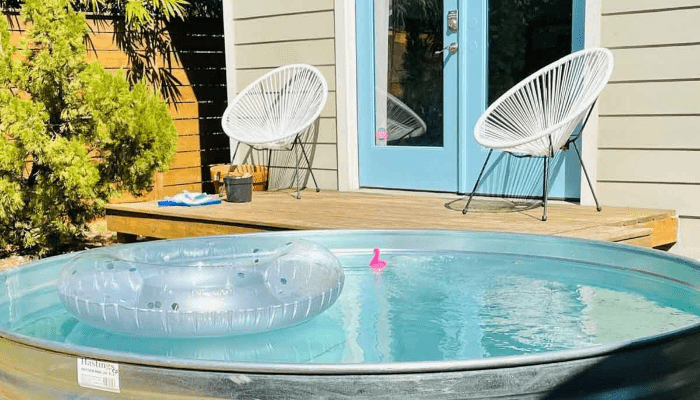
Design Ideas to Take It to the Next Level
A stock tank pool is functional. But it can also be a design flex.
Boho Vibes: Surround with potted palms, add a woven umbrella, throw in a striped towel and cold drink.
Desert Cool: Paint the tank matte black. Use terracotta planters. Add gravel and succulents. Done.
Modern Zen: Minimalist deck, privacy screen, water feature. A tiny spa without the spa price.
Kid Zone: Foam pool noodles, storage bench for toys, shade sail, and you’re the hero parent.
This is the kind of upgrade where you can start simple and add layers over time. First the tank. Then the deck. Then the fire pit. Then world domination.
Is a Stock Tank Pool Right for You?
If you want a cool-down zone without a contractor, yes.
If you’re into fast projects with high reward and minimal nonsense, definitely yes.
If you think a $40,000 in-ground pool is the only kind of backyard luxury, maybe not.
Stock tank pools are for renters, minimalists, maximalists, people with small yards, and people with big imaginations. They’re for families, introverts, backyard yogis, and DIY addicts who want a summer win without a spreadsheet.
It’s a stock tank. But it’s also a mindset.
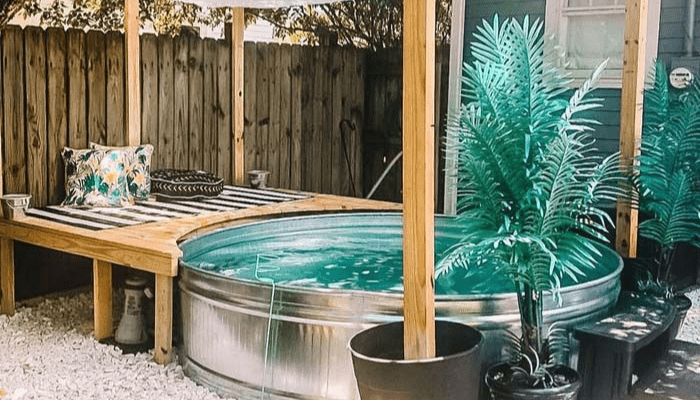
Want to Take It Further? Bring in Oásis Biosistema
If a stock tank pool is your jumping-off point, Oásis Biosistema is how you turn it into a full-blown outdoor sanctuary.
We specialize in natural landscaping, meditation gardens, and biosystem design that work with and not against your environment. That means native plants, low-maintenance materials, and spaces designed to restore both your body and your brain. Imagine your stock tank pool nestled into a wild-feeling garden, surrounded by lavender, stone paths, soft shade, and just enough structure to feel intentional, not over-designed.
We can help you integrate your tank into a broader ecosystem: build a custom deck, add water-wise irrigation, or create a minimalist meditation corner that makes your pool feel like it belongs there, not like it was dropped in on a whim.
Our work is about more than just aesthetics. It’s about creating outdoor environments that support your health, calm your nervous system, and make you want to step outside every single day.
Ready to turn your tank into something truly serene?
Let’s design your oasis.
Conclusion
Stock tank pools aren’t a trend. They’re a smart, sustainable answer to the endless summer question: how do I stay cool without losing my mind or my money?
You don’t need a massive yard. You don’t need a construction crew. You need a tank, some creativity, a weekend, and maybe a margarita. Whether you go DIY or buy a prebuilt setup, the result is the same: a pool that delivers joy without the baggage.
And if you want to take it further, integrate it into a meditation garden, wrap it with natural textures, or build a full outdoor sanctuary, you’ve got options. The point is, this isn’t about perfection. It’s about stepping into the water you created and thinking, yep, this feels good.
So here’s your permission slip. Make it rustic. Make it elegant. Paint it black. Leave it galvanized. Just make it yours.
The only mistake you’ll regret? Waiting until July to get started.
Ready to upgrade your backyard with a stock tank pool? Chat with us at Oásis Biosistema about custom landscaping and design that makes it feel like it was always meant to be there.
FAQ
Are stock tank pools a good idea?
Yes, stock tank pools are affordable, durable, and quick to set up. They’re ideal for small backyards, easy to maintain, and can be customized with filters or heaters for year-round use.
How much does a stock tank pool cost?
A stock tank pool typically costs €300 to €800 for the tank, plus €100 to €500 for a pump, filter, and setup. Total cost depends on size, accessories, and whether you DIY or hire help.
Can you swim in a stock tank pool?
Yes, you can swim in a stock tank pool, though they’re best for cooling off or lounging rather than full laps. They’re popular for wading, soaking, and small-space backyard relaxation.
What is the life expectancy of a stock tank pool?
A well-maintained stock tank pool can last 10 to 20 years. Longevity depends on material quality, water chemistry maintenance, and protecting it from rust or extreme weather.



